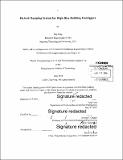Hybrid damping system for high-rise building outriggers
Author(s)
Feng, Jing, M. Eng. Massachusetts Institute of Technology
DownloadFull printable version (8.637Mb)
Other Contributors
Massachusetts Institute of Technology. Department of Civil and Environmental Engineering.
Advisor
Jerome J. Connor.
Terms of use
Metadata
Show full item recordAbstract
Recent design of buildings utilizes different strategies to mitigate the lateral displacement and acceleration from wind and earthquake excitation. One of the strategies is to dissipate external energy with dampers. For high-rise buildings, outrigger systems which connect the core and perimeter columns are innovative system, which to combine stiffness of both the core and perimeter columns to resist overturning moment. The bending moment is transferred through shear through the outrigger system. It is an efficient lateral resistance system and an ideal location for building damping systems. However, current damping for outriggers are limited to passive dampers. Although they can mitigate the fundamental vibration mode effectively, their non-adjustable property limits their efficiency. The objective of this thesis is to examine in-depth damping systems for high-rise building outriggers and to investigate the efficiency of hybrid damping system for outriggers. Fundamental dynamic analysis for structures are investigated and presented. Two hybrid damping schemes are discussed in terms of efficiency and performance under earthquake excitation. Finally, a hybrid outrigger damping system is recommended and simulation for a simplified Two Degree of Freedom outrigger with the recommend hybrid damping system are conducted. The results indicate that hybrid-damping outriggers have better performance compared to passive damping system for high-rise building outrigger systems.
Description
Thesis: M. Eng., Massachusetts Institute of Technology, Department of Civil and Environmental Engineering, 2014. Cataloged from PDF version of thesis. Includes bibliographical references (pages 79-81).
Date issued
2014Department
Massachusetts Institute of Technology. Department of Civil and Environmental EngineeringPublisher
Massachusetts Institute of Technology
Keywords
Civil and Environmental Engineering.